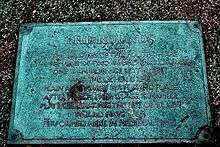Saint Kea
| Saint Kea | |
|---|---|
| Confessor | |
| Born | probably Lothian |
| Died |
early 6th century Cleder, Brittany |
| Venerated in | Roman Catholic Church; Anglican Communion |
| Major shrine | Cleder, Brittany |
| Feast | 5 November |
| Attributes | hermit with a stag |
Saint Kea (Cornish: Ke; French: Ké) was a late 5th-century British saint from the Hen Ogledd ("Old North")—the Brythonic-speaking parts of what is now southern Scotland and northern England. According to tradition he was chiefly active in Cornwall, Devon and Brittany, and his cult was popular in those regions as well as throughout Wales and the West Country. St Fili or Filius to whom the parish church of Philleigh is dedicated[1] probably came from Wales and is said to have been a companion of St Kea.[2]
Legend
Kea is chiefly known through a French summary of a lost Latin hagiography written by Maurice of Cleder in the 17th century, as well as Beunans Ke, an incomplete 16th-century Cornish-language play rediscovered in 2000.[3]
According to these, he was the son of King Lleuddun Luyddog of Lothian, and served as bishop in North Britain before moving on to become a hermit. He first went to Wales and then moved south, founding churches at Street, Somerset and Landkey, Devon (holy place of St Kea). He finally settled at Kea in Cornwall, which was subsequently named for him. He was harassed by the Cornish king, Teudar, when he sheltered a deer that Teudar was hunting. Having his oxen confiscated, he used the deer to plow the soil instead. He later travelled over the Channel to Cleder in Brittany, where he eventually died.

The work also describes Kea's dealings with King Arthur. According to the summary, Kea was called from Brittany to negotiate a peace between Arthur and his nephew Mordred before the Battle of Camlann. Kea then criticizes Arthur's wife Guinevere for her adultery with Mordred, leading her to regret her behavior. This passage probably explains the Arthurian section in Beunans Ke, which describes Arthur's conflict with the Roman emperor Lucius Hiberius and Mordred's subsequent treachery.
Plays featuring St Kea were performed at Playing Place, where a plaque marks the plain-an-gwarry field in which they were staged.
References
- ↑ Doble, G. H. (1964) The Saints of Cornwall; part 3. Truro: Dean and Chapter; pp. 89–103
- ↑ Ellis, P. B. (1992) The Cornish Saints. Penryn: Tor Mark Press, p. 12
- ↑ "Beunans Ke (The Life Of St Ke)". Llyfrgell Genedlaethol Cymru – National Library of Wales. Retrieved November 20, 2009. The play is held by the National Library of Wales.
Further reading
- Henderson, Charles (1929) Four Saints of the Fal: St Gluvias, St. Kea, St. Fili, St Rumon